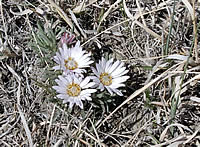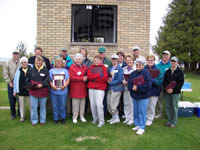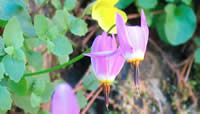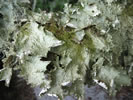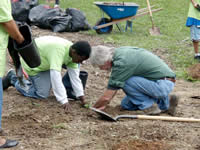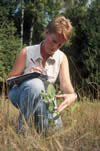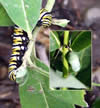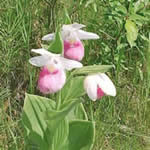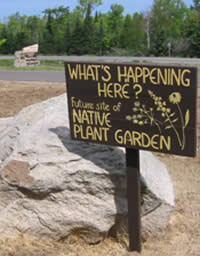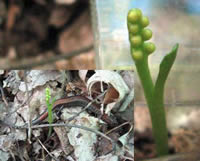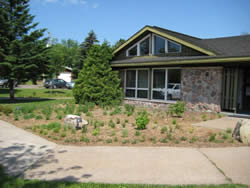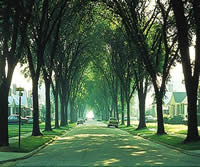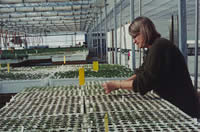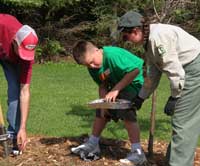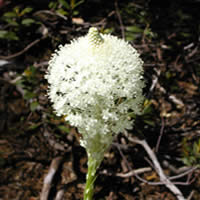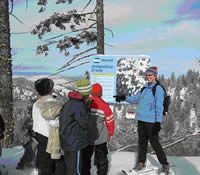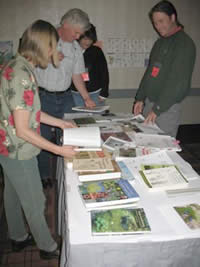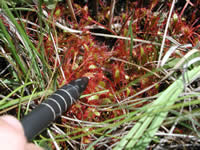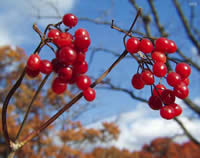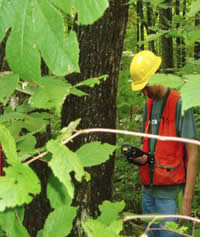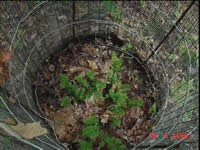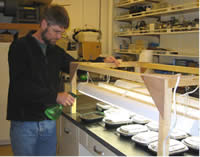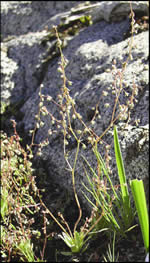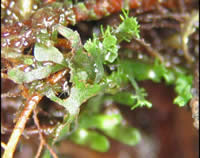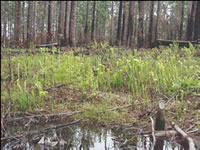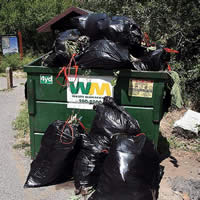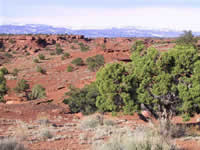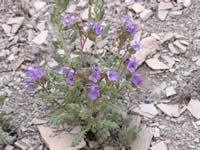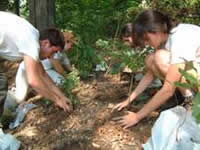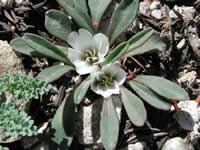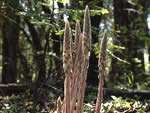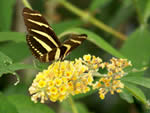USDA Forest Service Celebrating Wildflowers
|
|
|
Celebrating Wildflowers News ArchivesPlants of the Grand River and Cedar River National Grasslands is Available!
The Cedar River and Grand River National Grasslands contain a variety of habitats. The mixed-grass prairie, cottonwood riparian, and woody draws characteristic of the Northern Great Plains are all here. This diversity creates a welcoming sii for plant enthusiasts. The publication, Plants of the Grand River and Cedar River National Grasslands: 2008, by Kurt Hansen of the Dakota Prairie Grasslands, U.S. Forest Service, is available free to the public. This document includes 56 pages, a summary of the current list of known plant species found on the Grand River Ranger District. The current known number of plant species on the district is 470 plant species from 78 families. Much remains to be learned, Please, come explore this wonderful place and make discoveries of your own! The book is available at the Grand River Ranger District in Lemmon, South Dakota; the Dakota Prairie Grasslands Supervisor's Office in Bismarck, North Dakota; or, you can download it here (PDF, 2.80 MB). Hiawatha Hosts National Monarch Butterfly Workshop - July 2008The Monarch Conservation Techniques workshop was held on the Hiawatha National Forest June 3-5, 2008. This workshop, sponsored by the International Programs division of the Forest Service, was led by Forest Service biologist Janet Ekstrum and Forest Service plant ecologist Deb LeBlanc. The three-day workshop taught monarch larva monitoring and butterfly tagging techniques, native plant propagation and site restoration. The Hiawatha National Forest was chosen to host this workshop due to their nationally recognized monarch research project on the Stonington Peninsula and their native seed program and greenhouse in Marquette. Hiawatha National Forest's Monarch Butterfly Research Project Receives the Wings Across the Americas Award - June 2008
On June 4, 2008, the Hiawatha National Forest hosted a reception to honor employees, partners and individual volunteers whose involvement in the Hiawatha National Forest’s Monarch Butterfly Research Project over the past 15 years has lead to the receipt of the prestigious Wings Across the Americas (WATA) Award. Final Native Plant Material Policy - February 13, 2008The Forest Service has issued a new directive (Federal Register Notice, PDF,73 KB) for the use of native plant materials in the revegetation, restoration, and rehabilitation of National Forest System lands. This first ever national direction on native plant materials will help the Forest Service to develop and implement a native plant materials program throughout the Agency. The policy helps achieve the Agency’s goals of providing for the diversity of plant and animal communities, and restoring native species and habitat conditions in ecosystems that have been invaded by non-native species. Wasatch Shooting Star Surveys 2007
This summer, surveys for the rare Wasatch Shooting Star resulted in a documented DOUBLING of the population as well as expansion of the population range into Little Cottonwood Canyon. Prior to 2007 surveys, this plant had only been found in Big Cottonwood Canyon. Snowbird funded the survey team, the Utah Native Plant Society donated volunteer hours to assist in the surveys, Red Butte Gardens Conservation Center monitored existing plots, and the Wasatch-Cache National Forest coordinated the project, including data collection sheets, EO standards and more. A Fungus Among Us - Winter 2007Finding a species new to science is not an everyday occurrence. However, on the threshold of the 100th anniversary of the Chugach National Forest, Russian mycologist and senior researcher Dr. Misha Zhurbenko of the Kamorov Botanical Institute in St. Petersburg has discovered a new lichenicolous fungus on the Chugach. Prairie Planting at Milwaukee's Urban Treehouse Site on National Public Lands Day - September 2007
The USDA Forest Service's Milwaukee Regional Office and the America's Outdoors Center (U.S. Forest Service, National Park Service, Bureau of Land Management, and the U.S. Fish and Wildlife Service) celebrated National Public Lands Day on Saturday, September 29, at Lynden Hill, home of Milwaukee’s Urban Treehouse site. The Urban Treehouse site is a 3-acre green space in the heart of Milwaukee, where neighborhood residents and school children can come to learn about the values of green spaces and gardening with native plants. The main event of the day was the planting of over 300 native plants on the prairie mound. Peninsula Point Lighthouse is a Guidepost in Monarch Migration - September 2007
Today Peninsula Point is a NatureWatch and Watchable Wildlife Site - Michigan's "Point Pelee"-- where visitors and volunteers come to see and study the monarch butterflies (in late summer) that congregate near the Lighthouse, several hundred at a time waiting a favorable wind to cross Lake Michigan to the Door County Peninsula Wisconsin. (A great variety of shorebirds and upland spring and fall migrant birds also pass through!) But it hasn't always been this way. Plant It and They Will Come - September 2007
Monarch caterpillars and chrysalis are found on milkweeds planted in native prairie and pollinator gardens at the Wayne National Forest office in Nelsonville, Ohio. While maintaining newly planted prairie and pollinator gardens at the Nelsonville office, students Nick Galentin and Edward Entsminger came across some new visitors. These visitors were not of the two-legged form, but instead multi-legged variants eating milkweed leaves. Chippewa National Forest Unique Partnership Saves Showy Lady Slippers - August 2007
The Chippewa National Forest in North Central Minnesota is developing a unique public-private partnership to mitigate and reduce impacts of a highway upgrade along 15 miles of Trunk Highway 39, the Ladyslipper Scenic Highway. The major challenge of the partnership is to ensure that a population of several thousand Showy Lady's Slippers, the state flower of Minnesota, are not irreparably damaged or eliminated during the highway upgrade. Linda Parker, Forest Ecologist Receives the Karl Urban Celebrating Wildflowers Award for 2007 - August 2007
The Karl Urban Celebrating Wildflowers award recognizes a forest service individual who throughout their career has demonstrated dedicated leadership, excellence in natural resource management, and outstanding commitment to working with other agencies, states, tribes, non-government organizaitons (NGOs), and volunteers in the field of botany. The scope and significance of the nominee’s contributions to the native flora of North America are noteworthy and considerable. The 2007 National Celebrating Wildflowers award goes to Linda Parker who has made an important impact on the identification and development of native plant protocols, new directives, training and workshops, methodology, and research. She garnered numerous partners and volunteers in the process. Great Divide Native Garden Project (From Lawn to Garden) - August 2007
The Great Divide Ranger District, Chequamegon-Nicolet National Forest in Glidden, Wisconsin, developed a Native Plant Garden at their district office site. The Native Plant Garden began as an idea in early 2005. After a preliminary site search, a garden location was selected after consultation with district staff at the Glidden office (where the garden would be placed). They chose a site with high visibility, both to offer a place for visitor education as well as to help "beautify" the office grounds and reduce the area's mowed lawn. Besides providing a source for public education and enjoyment, an added benefit of the native garden is it provides the Forest with a ready source of seed for a variety of projects. As the season progresses, a percentage of the available seed is harvested from the garden by hand and stored for future projects. These may include seeding projects in campgrounds, along trails, in wildlife openings, or on temporary woods roads following closure. Regardless of the time of year, the Great Divide Ranger District invites you take a moment to walk about and enjoy their garden. Goblin Fern - July 2007
"One more reason to monitor: If you do not look, you will not find." Most rare plant surveys on the Huron-Manistee National Forest are conducted for areas of proposed logging and other planned activities, which are usually in less rich habitat types. On July 20, 2007, Christie Sampson and Greg Schmidt were testing the applicability of a vegetation sampling protocol on different vegetation types in conjunction with a routine project rare plant surveys. They found Botrychium mormo (Goblin fern), a first for the Huron-Manistee, and probably the southern-most occurrence of this species in Michigan. Had Schmidt and Sampson not been on their hands and knees looking carefully to identify all species present within a square meter area, this species in all likelihood would not have been found. The lesson (in moderation) is to slow down, wander off the preordained routes, and get down on your knees and look. Washburn Ranger District Efforts Support Eco-municipality Goals - July 2007
In search of a source for local, native plant seed to re-vegetate disturbed areas, the Chequamegon-Nicolet National Forest embarked on a plan to collect and grow their own seed. Native seed plots were started at several of the District Ranger offices including the Washburn office. Several local businesses were contracted for these projects. One of the projects was to install a rain garden to deal with "Lake Washburn", the name coined by District staff for an area near the parking lot where a "lake" appears for several days after a substantial rain or spring thaw. Fourth grade students from Washburn Elementary School helped with the planting of the rain gardens. American Elm Restoration on the Chippewa National Forest - July 2007
The Chippewa National Forest is initiating a project in 2007 to restore the American elm to the Forest’s landscape. Seedlings from crosses of native American elm trees with American elm strains with high levels of tolerance to Dutch elm disease (DED) will be established in areas where the trees can naturally regenerate and spread. The process of regeneration will allow American elms with genetic DED tolerance to co-evolve with the exotic DED fungal pathogen (Ophiostoma ulmi), to ensure this valuable tree species will not be lost from the Forest’s landscape. Partners in this effort are Northern Research Station, Delaware, Ohio; Northern Research Station, Grand Rapids, Minnesota; State & Private Forestry, St. Paul, Minnesota; State of Minnesota, and Leech Lake Band of Ojibwe. Forest Service Researcher Honored for Her Efforts to Develop Biological Knowledge and Seed Supplies of Native Species for Restoration - July 2007
Nancy Shaw of the Rocky Mountain Research Station, Aquatic Sciences Laboratory, Boise, Idaho, has been honored for her efforts to develop biological knowledge and seed supplies of native species for restoration. Nancy Shaw has worked with numerous researchers, federal and state agencies, and private seed growers across the western U.S. to advance the science of native plant propagation and use in restoration. She has presented more than 60 invited presentations at natural resources meetings and symposia, and has published her research findings in a wide variety of outlets. Nancy's work has improved the availability of genetically appropriate seed of native forb, grass, and shrub species so that land managers will have more choices and will be more successful in their rehabilitation and restoration plantings. Chequamegon-Nicolet National Forest: New Century Snapshot - Students Learn a Lesson that Keeps on Growing - June 2007
Lakewood and Laona, Wisconsin - What do you get when you mix eighty-one children with twenty species of plants and two offices? A whole lot of fun and learning that keeps on growing! In October 2006, the Lakewood-Laona Ranger District initiated a two-year agreement to create a supply of locally-collected native plant materials for restoration projects while connecting local students with the land on which they live. The District partnered with the Nicolet Distance Education Network (NDEN) to involve third and fourth grade students from the Laona and Wabeno Elementary Schools in the installation of gardens at both District offices for the Forest's Native Plant Program. NEW Website! - The Monarch Butterfly in North America - June 26, 2007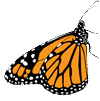 A new website, The Monarch Butterfly in North America, has been officially launched! The Monarch Butterfly website is a gateway to news, information, activities, and resources about the biology and conservation of this fascinating insect. This website is a cooperative effort with the North American Pollinator Protection Campaign (NAPPC) and agencies of the U.S. Department of the Interior and the U.S. Department of Agriculture dedicated to educating the public and increasing understanding monarch butterfly biology and conservation. Check it out! The Monarch Butterfly in North America » National Pollinator Week - June 24-30, 2007The Pollinator Partnership is proud to announce that June 24-30, 2007 has been designated National Pollinator Week by the U.S. Senate (S.Res. 580) and the U.S. Department of Agriculture. Resources are available on the Pollinator Partnership's website regarding Pollinator Week events happening across the country. Pollination Stamp Series to be Released by the U.S. Postal Service on June 29, 2007The U.S. Postal Service will release a four-design, 20-stamp Pollination booklet this summer. The four designs depict: two Morrison's bumble bees paired with purple, or chaparral, nightshade; a calliope hummingbird sipping from a hummingbird trumpet blossom; a lesser long-nosed bat preparing to "dive" into a saguaro flower; and a Southern dogface butterfly visiting prairie, or common, ironweed. The design emphasizes the ecological relationship between pollinators and plants and also hints at the biodiversity necessary to ensure the future viability of that relationship. The four designs are arranged in two alternate blocks that fit together like interlocking puzzles. In one block, the pollinators form a central starburst. In the other, the flowers are arranged in the center. Bear Grass Prescribed Burn for California Indian Basketweavers - May 2007
The Plumas National Forest Feather River Ranger District botanists, archaeologists, fire personnel and California Indian Basketweavers Association burned two and a half acres of bear grass, Xerophyllum tenax, on Friday May 18, 2007, on the Feather River Ranger District of the Plumas National Forest. This prescribed burn was at the request of the California Indian Basketweavers Association. Prior to the burn, monitoring transects were established to compare the total number and percent cover of plants before and after the burn. California Indian basket weavers have used bear grass for thousands of years and the plant is an essential element in traditional Maidu basketry art and culture. Bear grass that has not been burned is not useable for basket weaving. Many weavers in this area are currently out of bear grass due to the shortage of suitable populations to gather. Bear grass must be burned in order to produce flexible, strong leaves from the new growth that occurs 1-3 years after burning. Middle School Students in Medford, Wisconsin, Battle Buckthorn Invader in City Park - May 2007The Upper Chippewa Invasive Species Cooperative (a newly formed Cooperative Weed Management Area in north central Wisconsin), the Taylor County Lands Conservation Department, the Wisconsin Department of Natural Resources and USDA Forest Service, along with Fifth grade students and teachers from Medford, Wisconsin, Middle School have come together for the past two years to remove glossy buckthorn from the Medford Riverwalk City Park. Buckthorn is an aggressive growing shrub that quickly colonizes and crowds out native vegetation. SnowSchool at Bogus Basin’s Frontier Point Education Center on the Boise National Forest - April 2007
In 2007, nearly 700 elementary school children attended SnowSchool at Bogus Basin’s Frontier Point Education Center on the Boise National Forest. Students learned about winter adaptations of plants and animals, habitat diversity, and wildlife tracking. The Forest Botanist trained volunteer leaders in winter ecology and plant identification. Eastern and Southern Regions Partner on Non-Native and Invasive Species (NNIS) and Native Plant Classes at Eastern and Southern Regions University - March 2007
Over the past 16 years, the Eastern and Southern Regions University (ESRU) has become a learning institution for Forest Service personnel in these two regions. In March 2007, the ESRU convened in Columbus, Ohio. For the last 5 years, The Nature Conservancy, State and Private Forestry, and the Eastern and Southern Regions of the Forest Service have partnered to offer three classes relating to invasive species and native plants. Sundew New to Colorado Found on the San Juan National Forest - March 2007
While surveying fens on the Columbine District, San Juan National Forest, Colorado, in July 2006, Alison Brady discovered a population of English sundew (Drosera anglica). Globally, sundews are one of the largest genera of carnivorous plants with over 170 species, but only 12 are native to the United States. This discovery adds a new species to the flora of Colorado. Until now Drosera rotundifolia (roundleaf sundew) has been the only Drosera species observed in the state. Chippewa National Forest - Native Woody Seed Collection - January 2007
Leech Lake Band of Ojibway tribal members gathered fruit from the designated native woody plant species. Quantities of most fruits in seed zone 1 were severely limited in 2006 due to a major drought. Funding for this project was the U.S. Forest Service Native Plant Materials Earmark of 2006. This project was initiated to increase the Chippewa's seed bank for several woody species stored at the Forest Service J.W. Toumey Nursery. Target species were those not typically used for reforestation purposes, or if used for reforestations were obtained only with great difficulty. Preserving Healthy Butternut on the Chequamegon-Nicolet National Forest - January 2007
Employees of the Oconto River Seed Orchard searched for healthy butternut at locations where it had been recorded on the Chequamegon-Nicolet National Forest. Twigs were collected from the tops of healthy trees in mid-winter and grafted onto black walnut seedlings. These grafted plants will be planted in the field at the seed orchard. This planting will preserve healthy butternut and eventually provide seed for butternut restoration projects. We hope to expand this effort to other National Forests and non-Forest Service lands. Molecular Test Determines which Yews on Huron-Manistee National Forest are Native - January 2007
Foliar samples were collected from known populations of Taxus canadensis and known populations of exotic yew species and sent to the National Forest Genetics Lab (NFGEL) in Placerville, California. NFGEL found differences in the molecular structure of enzymes between native and exotic yews. When samples from unknown yews on the Forest were compared to the known samples it was possible to determine which ones were native. Taxus canadensis is a sensitive species on the Huron-Manistee NF because much of it has been eliminated by of heavy deer browse. It was not clear if the few remaining yew were natives that should be protected or exotics that should be removed. Awards for Celebrating Wildflowers Website - January 2007
Since posting the Celebrating Wildflowers web pages on the Forest Service website, we have received numerous e-mails complementing the agency for various aspects of the site. Recently, the Forest Service was recognized for the quality of the Celebrating Wildflowers website receiving The Talking Hands Award and the Disability Network 2007 Outstanding Website Award. Forest Service employees, volunteers, and partners are very proud and honored by the recognition received by the Celebrating Wildflowers web pages. Growing Sword Ferns from Spores in the Dark Days of Winter - January 2007
The Sitka Ranger District (Tongass National Forest), National Park Service, University of Alaska Cooperative Extension Service. and the U.S. Geological Survey are cooperating to grow sword ferns from spores as a component of a native plant propagation project. Sword ferns are showy ferns, valuable for landscaping or re-vegetation projects. Four sword fern species are native to Baranof Island, where Sitka is located, and are adapted to a variety of habitats and transplant well. None of these large evergreen ferns is abundant enough to sustain commercial harvest. Propagation by spores may be a way of producing enough plants for restoration projects or use by local landowners. Simple protocols are being tested to grow the ferns. Spores were collected in the wild, sown on sterile soil in special covered containers. They are provided with light 12 hours a day and carefully misted to provide moisture. After three weeks the first tiny germinated ferns were visible. We hope to nurture these tiny bits of green into luxuriant adult ferns. Payette National Forest Partnership with Red Butte Garden Helps Conserve Imperiled Plant, Tobias Saxifrage, in Idaho. - November 2006
This rare endemic to the subalpine region of the West Salmon River Mountains is found only on the Payette National Forest. Named after a local conservationist, Nell Tobias, the plant produces few seeds and relies on small plantlets or bulbils for reproduction. Bulbils of Tobias saxifrage were collected this spring from remaining populations at Pearl Creek and sent to Red Butte Gardens in Utah for propagation. These plantlets will receive expert care from the staff at Red Butte until they can be planted back into national forest lands that were “burned-over” by wild fires. Following recent fires, known sites of Saxifrage bryophora var. tobiasiae in the Pearl Creek drainage, Payette National Forest, were destroyed. Since only six populations of Tobias saxifrage are known to occur on the Payette National Forest, it is important to propagate local genetic material for restoration. Past reproductive biology research done by Kim Pierson, the Forest botanist on the Sawtooth National Forest, contributed to our understanding of the plants ecological and biological characteristics, allowing for successful reintroduction. Finding the Elusive Wright’s Filmy Fern on the Tongass National Forest - November 2006
The tiny fern, Wright’s filmy fern (Hymenophyllum wrightii), grows in Japan and Korea and the temperate rain forests of the northwest coast of North America. Moss experts discovered the fern in British Columbia in 1957 and in Alaska in 1965. It is rare in British Columbia and was known in only two places in Alaska. In July, a team of botanists, armed with flashlights and magnifying glasses, conducted concentrated surveys to locate the fern in southeastern Alaska. The botanists found the plant at 15 places near Petersburg and Sitka. In 2006, botanists have found the fern at 40 other locations in southeastern Alaska. Pitcher Plant Restoration - October 2006
The Kisatchie National Forest has partnered with Northwestern State University’s biology department, Natchitoches Parish, and a local construction company. Funding was secured with a grant of $86,000 from the Coypu Foundation to the NSU biology department to accomplish native plant conservation including the restoration of pitcher plant bogs in Louisiana. Cottonwood Canyons Foundation 2006 Invasive Weed Program: Final Report - October 2006
The Cottonwood Canyons Foundation Invasive Weed program was sponsored this summer by funding from the Wasatch-Cache National Forest, a partnership grant from the Bonneville Coordinated Weed Management Area and in-kind support from Salt Lake County Public Works, who picked up pulled weeds for proper disposal. Volunteers chipped in a ton of hours and sweat effort to map invasive species and pull weeds. Federal Agencies finalize Conservation Agreement to protect five Central Utah Navajo Sandstone Endemics - October 2006
A Conservation Agreement and Strategy (PDF, 692 KB) to protect five rare endemic plants in Central Utah was signed by federal land management agencies this past month. It is the culmination of an interagency partnership that began even years ago to share botanical expertise and resources to conduct range-wide surveys (regardless of agency ownership) to understand the distribution, range, threats, and opportunities to manage shared species. The five species protected through this Agreement include: Maguire’s daisy (Erigeron maguirei), Wonderland Aliceflower (Aliciella caespitosa), Mussentuchit gilia (Aliciella tenuis), Harrison’s milkvetch (Astragalus harrisonii) and Pinnate springparsley (Cymopteris beckii). Uinta National Forest Introduction Program to Recover Clay Phacelia, one of Utah’s most Endangered Species - September 2006
Known from only two small populations on private lands, the Forest Service is contributing to recovery efforts of one of the nation’s rarest plants, the Endangered Clay phacelia (Phacelia argillacea) by taking action to establish new populations on federal lands. Over the past decade the Uinta NF has conducted extensive surveys in suitable habitat on federal lands adjacent to occupied sites but no additional populations have been found. Field surveys conducted in 2001 indicated an alarmingly low number of plants in the known populations due a series of natural and weather related factors (drought, predation, etc.) which subsequently led to the need for urgent action to begin Seed collection for ex-situ testing and seed bank expansion. The goal is to establish up to 13 new populations on federal lands that would ensure that this species does not go extinct. Native Plant Rescue: Saving Our Natural Heritage - Wayne National Forest - September 2006
Personnel from the Wayne National Forest and volunteers from Hocking College, Rural Action Appalachian Resource Center, Ohio University, United Plant Savers, Frontier Natural Products Cooperative and the National Forest Stewardship Program came together in September to salvage many native plants from the future site of the U.S. Highway 33 bypass that will cut through the Wayne National Forest. Among the many species saved were a number of economically important medicinal plant species such as, goldenseal, black cohosh, blue cohosh, and bloodroot. Some of the salvaged plants were transplanted into other young, second growth forests on the forest. Most of the salvaged plants were planted into beds located at the Athens Ranger District Office. These plants will produce valuable seed for use in future revegetation and restoration projects on the forest. New Plant Species Named after Sacajawea Found in Boise National Forest - May 11, 2006A species new to science - Sacajawea's bitterroot (Lewisia sacajaweana) - is the first plant species to be named in honor of Sacajawea. An Idaho native, this rare and beautiful plant occurs nowhere else in the world but Central Idaho. Just over two dozen populations of Sacajawea’s bitterroot are known to exist - roughly 75 percent of them on the Boise National Forest. Scattered populations also occur on the Payette, Sawtooth, and Salmon-Challis National Forests. Lichen and Bryophyte Groups Visit Wayne National Forest - Spring 2006Visiting groups spent several hours collecting specimens in the Symmes Creek area, taking them back to the Shawnee State Park lodge, where they were identified. One of the goals of the workshop was to develop lists of lichens and bryophytes for each area visited. The Symmes Creek lichen list contained more species than any of the other sites visited. The Symmes Creek area is recognized as a hotspot for moss and lichen diversity as well as a premier habitat for these taxa. The area contains a variety of tree bark, soil, and rock habitats. Groups included member of the Wayne National Forest, Ohio Moss and Lichen Association members, Lichen and moss experts throughout the Eastern United States, and herbaria (New York Botanical Garden, Philadelphia Museum of natural History, University of Nebraska, Kent State university, Ohio State University) |
|
| NOTE: PDF format links require the Adobe Acrobat Reader to view. | |
| top | Disclaimers | FOIA | Privacy Policy | Quality of Information | Photo Credits & Use |
Location: http://www.fs.fed.us/wildflowers/news/archives.shtml
Last modified: Thursday, 12-Mar-2009 10:26:31 EDT
